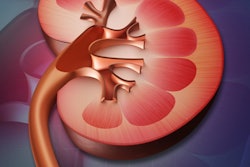
The U.S. Agency for Healthcare Research and Quality (AHRQ) has released a summary of two major evidence reviews on the risks of contrast-induced nephropathy (CIN), stating there are only three proven strategies for preventing CIN.
The comparative review of contrast agents included data from 29 randomized controlled trials and 10 observational studies published from 1988 through 2015. The systematic review on prevention strategies included 163 randomized controlled trials and 23 observational studies published from 1998 through 2015.
The researchers concluded that the risk of CIN does not significantly differ between various forms of low-osmolar contrast media (LOCM), and evidence supports only three precontrast interventions that are aimed at reducing the risk of CIN.
Underwhelming evidence
CIN is a complication arising from the use of iodinated contrast media for medical imaging, the group wrote. In the absence of better alternatives, it has been defined as an increase in serum creatinine of more than 25% or 0.5 mg/dL within two to three days following injection of contrast media.
The criteria come from the National Kidney Foundation Kidney Disease Outcomes Quality Initiative, which recommended their use in 2013 for all types of acute kidney injury including CIN, the AHRQ panel wrote.
The osmolality of a contrast medium is key in determining its nephrotoxicity. Low-osmolar contrast media replaced high-osmolar media as the standard of care for intravenous (IV) or intra-arterial (IA) injection a decade ago.
Iso-osmolar contrast medium (IOCM) is the newest type of iodinated contrast agent, with an osmolality the same as plasma. Only one form, iodixanol, is currently available, the group wrote.
Prevention
Although many strategies have been used to try to prevent CIN, including oral hydration, the use of sodium chloride or bicarbonate to expand volume, administration of N-acetylcysteine (NAC) or statins, and the withdrawal of various drugs, only three techniques have evidence supporting their use for prevention:
- N-acetylcysteine plus IV saline is superior to IV saline, either alone or with a placebo, when a LOCM is used, a recommendation with moderate strength of evidence.
- Low-dose NAC plus IV saline is superior to IV saline, either alone or with placebo, but the strength of evidence is low. Low-dose N-acetylcysteine is defined as 1,200 mg/day or less.
- Statins plus NAC plus either IV saline or bicarbonate is superior to NAC plus IV saline or bicarbonate in patients receiving IA-administered contrast media, but again with low strength of evidence.
Evidence
The studies found that the risk of CIN does not differ between the various types of LOCM, though evidence strength is low. Second, the analysis found that iso-osmolar contrast media has a slightly lower risk of CIN than LOCM, with moderate strength of evidence.
The lower risk was statistically significant but unlikely to be clinically important, the researchers added. And the risk of CIN was similar for both LOCM and IOCM when studies involved intravenous administration with a low strength of evidence, or intra-arterial administration with a moderate strength of evidence.
Complete information on the AHRQ studies is available here.




















